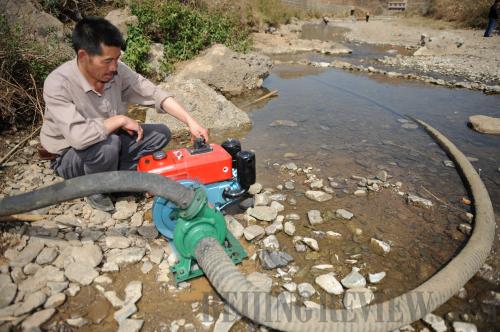|
 |
|
GOOD TO THE LAST DROP: A villager of Dawan Village of Pu'an County, Guizhou Province, uses a water pump to lift water from a drying pond to his tomato field (LIU JI) |
"The ravages of ongoing drought show what China's southern areas lack is not just water, but small farmland irrigation projects," said Zheng Fengtian, Deputy Director of the School of Agricultural Economics and Rural Development, Renmin University of China.
The worst-hit areas, Yunnan and Guizhou provinces and Guangxi Zhuang Autonomous Region, are subtropical and blessed with bountiful annual precipitation and a large number of rivers. Most often people's concerns about natural disasters relate to floods rather than droughts. But the present and lasting drought spell, the worst in decades, has left farmers with nothing to do but watch their land miss spring plowing. Dry cracked land, mostly without irrigation facilities nearby, cannot be sowed.
The situation used to be better in these areas. In the 1950s and 1960s, when the land was farmed under collectives, the government invested aggressively in building a large number of irrigation facilities in the countryside all over China. The government investment equipped the majority of China's rural areas with effective irrigation systems. Summarizing the country's achievements in building irrigation projects nationwide over 40 years, a document issued by the Ministry of Water Resources in 1990 said China's total farmland area that could be effectively irrigated stood at 49 million hectares between 1949 and 1979, one quarter of the world's total. China, whose total area of effectively irrigated farmland ranked first in the world, also had a per-capita figure higher than the world average.
China launched reform of household contract responsibility systems in rural areas in the late 1970s, which allowed farming households to manage agricultural production on their own initiative while the contracted farmland remained in the ownership of the rural collective. But the reform failed to contract irrigation facilities out to rural households, and the facilities ended up crumbling from lack of maintenance.
Meanwhile, resources marshaled by the Central Government to build irrigation facilities for agriculture also shrank steadily. The Ministry of Water Resources says that, over the past three decades, only 827 reservoirs have been built nationwide, compared to 86,000 reservoirs between 1949 and 1979.
Of China's total 124 million hectares of farmland, 57.8 million hectares can be effectively irrigated, only 8.8 million hectares more than 30 years ago. The newly irrigated land is mainly located in China's central and western areas.
"Farmland irrigation facilities built in the 1950s and 1960s are mostly collapsing while farmers are not motivated to build new facilities, leaving production to depend purely on the weather," Zheng said.
Outdated facilities
Last June, the Standing Committee of the National People's Congress, China's top legislature, sent inspection teams to provinces including Henan, Hebei, Jilin, Sichuan and Shaanxi to collect first-hand information on conditions of local agricultural water facilities.
They reported most irrigation facilities were obsolete and had not been repaired in a long time, while less than half of facilities were intact. A majority of pump stations failed to reach their design irrigation capacities and some had become completely non-functional. Of large pump stations nationwide, more than 85 percent were badly in need of overhaul.
Only 48 percent of China's total farmland could be effectively irrigated while production in remaining areas was totally reliant on weather factors.
Most of China's current irrigation projects are more than 50 years old with outdated facilities, said Qu Yanping, an engineer with a disaster reduction engineering research institute of the Ministry of Water Resources. Nearly 80 percent of farmland with irrigation facilities could only resist regular droughts, and irrigation projects in many areas lacked supporting facilities.
"An important reason behind the backwardness of irrigation facilities is the ambiguity in who should be responsible for building and maintaining small irrigation facilities," Zheng said.
Before the household contract responsibility system was adopted, government and rural collectives were in charge of building and maintaining small irrigation projects. Following the reform, which contracted farmland to households, farmers believed the responsibility of building and maintaining irrigation facilities was still the government's, while meager profits from growing grain dampened farmers' enthusiasm to invest in irrigation facilities. In these circumstances, many irrigation facilities are still left unattended.
Between 1980 and 2008, government investment in farmland water facilities accounted for only 6 percent of its investment in water utilization infrastructure, according to the Ministry of Water Resources.
Although the Central Government earmarked money for water infrastructure projects every year, the bulk was spent on building massive hydropower plants, reservoirs and dams. Smaller amounts were allocated to building irrigation ditches and nothing was left for maintaining existing facilities. When a drought strikes, the ill-maintained facilities cannot cope with the emergency.
"The ongoing drought disaster has once again alerted us about the pressing need to maintain our irrigation facilities," said Zheng.
Experts' suggestions
Given the serious situation, agriculture experts believe that it is imperative for the government to invest money and farmers to put in labor to restore and protect the farmland water utilization facilities. In the wake of emergency, Zheng said, the government should explore and map out long-term, practical models of water facilities construction that suited China's household-based agricultural production and ensured greater resources would be mobilized in this cause.
| 